April 20, 2011 -
Posted by Jaan Saks
Sportlyzer has been live about one month now. It has been a very interesting time for the whole team. Lots of challenges, feedback, ideas, bug fixes, improvements, more feedback, more challenges and so on. There are so many things going on at the same time that sometimes you miss the most important ones. Here’s something we should have done a few weeks ago, but better late than never: our weekly updates – check them out!
 Users Guide is now in reach of just one click. No matter where you are in Sportlyzer, you can always find the blue “Users Guide” button on the right. Just click it whenever you have questions. If you have more time, check the Users Guide out anyway – you may find some cool features you haven’t tried yet.
Users Guide is now in reach of just one click. No matter where you are in Sportlyzer, you can always find the blue “Users Guide” button on the right. Just click it whenever you have questions. If you have more time, check the Users Guide out anyway – you may find some cool features you haven’t tried yet.
Log in with different accounts. Logging in is so much more convenient now, when all your accounts (Facebook, Twitter, Google, Yahoo) are connected to your name, so you can log in with any account you want!
Better support. We have improved our support system and some extra effort went into supporting the users of Internet Explorer 7 and 8.
Garmin .tcx file upload. File upload to workouts is smoother and besides Polar .hrm and .gpx files, you can also upload Garmin .tcx files.
New Goal page. Each goal has now its own page. Whenever you enter a goal (Boston Marathon for example), it gets a separate page that unites all the users who are going to the same event. You can share tips, ask advice or find new friends via similar goals! Click on the event on your profile to go to Goal page.
While we continue our work on improvements and new ideas, it’s time for you to try out these updates!
Log in and see you inside!
April 13, 2011 -
Posted by Jaan Saks
We have received quite a lot of questions about how to read the data in heart rate monitors and how to match this data with Sportlyzer’s workout entries. As every heart rate monitor is slightly different and manuals may not always answer to those questions,we decided to cover this topic with a blog post.
To know your time spent in each zone, you have to enter your aerobic and anaerobic threshold data into your heart rate monitor. In most cases you can enter them as heart rate limits, whereas Limit 1 is your aerobic threshold and Limit 2 your anaerobic threshold. If you don’t know or remember your heart rate limits, you can find them in Sportlyzer. You can find them in ‘Settings’ – ‘Profile’. Limit 1 equals to max value of Zone 1 (aerobic threshold) and Limit 2 equals to max value of Zone 2 (anaerobic threshold). Please keep in mind that in order to get accurate results, you have to enter your registration data correctly!
After setting your aerobic and anaerobic limits, your training intensity will be divided into three parts:
Zone 1 – below Limit 1;
Zone 2 – between Limit 1 and Limit 2 and;
Zone 3 – higher than Limit 2.
If your heart rate monitor supports .gpx, .tcx or .hrm file type, you can upload the files manually to Sportlyzer. In case your heart rate monitor doesn’t support uploading file types or you are unable to connect your heart rate monitor with your computer, you have to edit the limits manually. Simply check your training time in each zone, usually referred as below zone (Z1), within zone (Z2) and above zone (Z3), and write your workout data accordingly to Sportlyzer. If your workout consisted of some low activity time period (e.g. between ballgames, between running sessions etc.), subtract this time from Zone 1 and add it as Zone 0. Some heart rate monitors do it automatically, so if there is a difference between your recorded total training time and time spent in zones add the missing time to Zone 0.
The explanations above should cover most of the heart rate monitors. However, if some of you still face difficulties while matching the data with Sportlyzer system, please let us know and we will try to find a solution.
March 30, 2011 -
Posted by Jaan Saks
“Tomorrow I will do it for sure.” Everyone has thoughts like that. Sometimes we have good reasons to postpone intended activities. However, people – especially those who set rather high standards to themselves and apply perfectionism in everything – often put off things they actually want or need to do. This is called procrastination – avoidance of doing tasks that are necessary. Besides, failing to do things on time (or to do things at all) is often accompanied by feelings of guilt, inadequacy, self-disgust and even depression.
 Why’s that?
Why’s that?
Imagine: you prefer mango to papaya, and pineapple to mango. If you had a choice between these three, you would probably pick pineapple – it is the best. Procrastination has a similar logic: we start to think that a point of time in the future is better than now (I’ll be less tired, less busy, in a better mood etc.). In this way we start to hope that tomorrow is a better time for exercising or going to the gym, or visiting a doctor.
Why is it so easy to do something that ultimately backfires?
People postpone (or actually skip – they just don’t call it skipping) one workout because no single workout is responsible for attaining the goal. Thus, it is not a big deal to start tomorrow. The same way people don’t stop smoking because no single cigarette can be blamed for lung cancer. So, they plan to quit next week. And this way we slowly postpone important events in our lives.
Is there hope for procrastinators?
Yes, there is. The solution is in deliberate and detailed planning. This is one of the reasons why Sportlyzer was created – it helps you to create a specific plan and a set precise starting time for every single workout. Just having a goal and an intention to achieve your goal is not enough. The most important thing is to have an implication plan – a specific planning strategy.
Join now and see you at workout planning!
March 22, 2011 -
Posted by Jaan Saks
Sportlyzer launched a virtual trainer that focuses on training advice – a required supplement to numerous exercise tracking applications and devices. Sportlyzer is providing a virtual trainer that uses complex algorithms to compose and modify workout plans and give training advice based on a user’s previous workouts and current training schedule. Just as well as a real trainer. This major step is the result of months of hard work and development – yet it is just the beginning of the next generation virtual trainer.
Sportlyzer’s uniqueness is based on 2 core features:
- Relevant training advice delivered by the virtual trainer
- Uniquely tailored training plans which adapt to changes.
The virtual trainer is supported by social networking which enables users to do numerous training related things. Hereby we would like to give a short overview about the possibilities in the public beta.
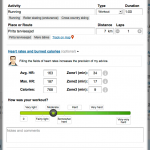 Workout log.
Workout log.
Adding and editing workouts is made easy. Workouts can be added either manually or from a heart rate monitor (Polar .hrm and .gpx are currently supported types). It is also possible to add multiple workouts to the same day.
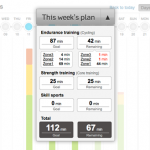 Goal setting and individual workout plans.
Goal setting and individual workout plans.
Based on physical characteristics, goals and previous workout history, Sportlyzer’s algorithms tailor a unique workout plan for each user. Workout plans are flexible to changes and are therefore modified after every change in scheduled workouts.
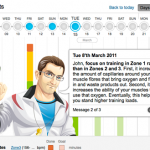 Training advice from the virtual trainer.
Training advice from the virtual trainer.
Virtual trainer gives training advice based on individual workout plan and data from previous workouts: suggests training loads and warns if user’s training load is too high or too low. As common in newer sports practices, the training advice is concentrated on heart rate zones and minutes instead of kilometers/miles. Explanations are available for the beginners and to those who are new to this system.
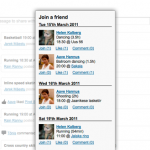 Workout community and shared training routes.
Workout community and shared training routes.
One of the most common reasons why people skip workouts is lack of people to train with. “Community” and “Join a friend” tools in Sportlyzer enable users to share workouts and join friends’ trainings with just one click. Besides trainings, it is also possible to track your favourite routes on map and “borrow” interesting training routes from your friends.
Sportlyzer’s team is working with further improvements. Until then, everyone is welcome to join, try and give us feedback, so we could tailor our virtual trainer according to our users’ needs.

February 3, 2011 -
Posted by Jaan Saks
Have you ever felt tired and drained out at the end of a long workday or at the end of the week? Tempted to skip the workouts you have planned for yourself? Tiredness is one of the most common reasons to skip exercise but there are ways to make it work, even when there is no energy left.

Strangely enough, people tend to skip pleasant activities when feeling bad. It is often tempting to skip workout because of fatigue and boredom and read a nice book or have a glass of wine or beer instead. Actually, it is very human to be irrational. And yet, it is even more human to do something about it! There are several easy ways to overcome those little motivation crisis. Hereby I would like to share a few of them with you:
- Think outside the box! On those days when you feel tired and your typical training routine doesn’t motivate you enough to leave the couch, think of the activities that you have enjoyed in the past. Maybe you used to play badminton when you were a kid or perhaps enjoyed swimming? Just try something different to spice up your typical workout routine.
- Invite or join a friend! It’s always harder to hoax a friend than yourself – having a common workout time is always a good laziness killer.
- Choose an easier exercise! While being very tired, even a thought about a hard workout makes you want reject it. So, instead of skipping your workout, go for an easier one.
- Try morning workouts! If you are a morning person, try to go for a morning run or swimming before work. It makes you feel fresh and finding a training motivation is also easier. However, if you are not a morning person, even 5-10 minutes of exercising in the morning increases your metabolism and wakes you up.
- Use weekends! If you are too tired to work out on workdays, try to pitch just training or two into your working days and leave the rest for the weekend. In that case try to balance this with workouts on both weekend days.
- Take the training bag with you! In case you prefer to work out during workdays but still struggle with training motivation from time to time, the easiest way is to take your training bag with you to work and go to training directly from work without meeting your couch in between. It is a simple advice but it really works.
So, just take a moment and think about how you can make starting a workout more appealing. You may feel tired at this very moment but this feeling alone does not preclude your workout, the feeling does not step in your way and hold you back. You can very well take your tiredness together with you to the gym and leave it there ;)
January 20, 2011 -
Posted by Jaan Saks
Until now we have talked about problems related to too few exercise. However, believe it or not, some people suffer from too much exercise, a condition called exercise addiction.
 Individuals with exercise addiction train at a duration, intensity, and frequency beyond that required for healthy exercise and reasonable working load. Most often, people with exercise addiction try to maintain a rigid schedule of intense exercise, and feel guilty when this schedule is violated. Moreover, physical signs similar to drug addictions appear: exercise addicts skip school or work, they forget social and family events, exercise even when ill or tired, and keep detailed training journals of their workouts. For instance, some people reject challenging carreer opportunities in order to get a job as a coach in the gym and be able to exercise whenever possible.
Individuals with exercise addiction train at a duration, intensity, and frequency beyond that required for healthy exercise and reasonable working load. Most often, people with exercise addiction try to maintain a rigid schedule of intense exercise, and feel guilty when this schedule is violated. Moreover, physical signs similar to drug addictions appear: exercise addicts skip school or work, they forget social and family events, exercise even when ill or tired, and keep detailed training journals of their workouts. For instance, some people reject challenging carreer opportunities in order to get a job as a coach in the gym and be able to exercise whenever possible.
Have you met someone whose commitment to exercise has become a compulsion? Like other addictions, exercise addiction may include physical & psychological addiction. The drive prevents normal life, it starts to interfere instead of enhancing someone’s life. Intense exercise dependence can lead to permanent physical damage, as the body is not allowed to recuperate between workouts. Psychologically, exercise addicts feel unable to stop exercising. Specifically, exercise addiction is characterized by deep feeling of dread when a workout is missed. Addicts experience loss and disappointment when an exercise “high” is not attained. The workout schedule of an addict is very strict, the nature of the workout activity is usually simple and does not include much intellectual challenge. Mostly, addicts exercise alone similar to drinkers drinking alone.
What would help? Exercise addicts get relief when introducing noncompetitive and versatile activities delivering fun, not just removing feelings of guilt. The most important tip is to plan resting days as well as to alternate the nature, duration, and intensity of workouts. Remember, less is sometimes more.
December 30, 2010 -
Posted by Jaan Saks
For many people, mixed feelings of dread and bad expectations arise in the final days of a year. But such a dread can also be accompanied by expectations full of wonderful promise. The promise of Christmas is followed by the promise of New Year’s Day – a time for new beginnings and resolutions aimed at changes for the better. Those are our unrealistic expectations and attitudes that give rise to our bad expectations:
 Aim for your destination, concentrate on the journey. How pleasant it feels to dream about the happy, healthy, and productive person I’ll become after I have got down to it on the January 1st! However, willpower is not enough for long-term success. Willpower is just a good basis for careful goal setting and planning.
Aim for your destination, concentrate on the journey. How pleasant it feels to dream about the happy, healthy, and productive person I’ll become after I have got down to it on the January 1st! However, willpower is not enough for long-term success. Willpower is just a good basis for careful goal setting and planning.
Motivation evolves from small successes. Even if you feel full of power for big changes, only keeping the ultimate outcome in mind most likely won’t help you for long time. Break down large goals into smaller ones, and keep your concentration on the closest one. For instance, if your resolution is to lose 8 kg, then joining a swimming club and improving your eating habits are two general action plans. Now, list all steps that are required to take, accompanied by target dates and strategies for maintaining new habits once you reach your goal. A SMART specific action goal for the first week could be two swimming workouts of 30 minutes each. This is a specific, measurable, action-oriented, realistic, and time-related goal. Even if you didn’t lose any weight by the end of the week, you are one step closer to your ultimate goal – you have already changed your habits.
Make a daring Plan B. If you aim your goal, it is wise to make plans for setbacks. One could think about alternative workouts that can be grabbed at when swimming plan is changed by holydays, betraying exercise buddies or simple boredom.
Happy New Year’s resolutions!
December 15, 2010 -
Posted by Jaan Saks
Finding the motivation to train or do exercise on a regular basis isn’t always easy. Demanding schedules and illness are just a couple of the things that can interrupt your fitness routine. Motivation can be found by following the SMART approach to goal setting. Many athletes, coaches and serial exercisers use this formula successfully to set both short and long-term training goals.

Setting your goals – remember be SMART:
- Specific – these are the most motivating goals. A specific goal is to reduce the time you take to swim 1000 m from 30 minutes to 20 minutes within 6 months. Quite often people just say they want to get faster. That is far too general to really motivate you in the pool.
- Measurable – it means that simply saying that you want to get faster is not enough. You need to be able to map the progress toward your goal. One way to measure your progress is to assess your performance at set intervals. In the above example you may want to time your 1000 m swim twice a month.
- Adjustable and Action-Oriented – goals help you only if they are flexible enough to allow for unexpected changes. An illness or injury may force you to readjust your goal. It doesn’t need to mean abandoning all your plans and dreams, you just need to find another way to action them. Importantly, keep your plans focused on your actions. Quite often people focus only on what they want to achieve, but forget to plan how to achieve it.
- Realistic – base your goals on your actual situation. If you never swam 1000 m, start by planning small sub-goals. Swimming 1000 m in 20 minutes is a perfect long-term goal, but in the short-term you may want to shoot for 35 minutes. This is a healthy and realistic plan. On the other hand, if goals are too easy, you won’t get much satisfaction from attaining them.
- Time-related – connect your measurable, realistic and challenging goals to your schedule. In our example this would be to reduce the time taken to swim 1000 m within 6 months. You may also need to set interim goals with shorter timelines to keep your landmarks in view. Note that having only goals that are achievable in more than 6 months, will make heavy demands on your motivation. Try to re-evaluate your progress every 2-3 months.
Last but not least, goal setting is not actually a prerequisite for attaining your goals. Nor can setting goals ever guarantee achievement of those goals – because all sorts of obstacles can hold you up. However, goal-setting is a tried and trusted technique to improve concentration and motivation, and so it increases the likelihood of achieving your dreams.
November 17, 2010 -
Posted by Jaan Saks
As many as half the people who start training drop out again within six months – and the most frequent reason given is lack of time. If we looked closer, we’d probably see that in most cases it’s more a matter of managing the time available than having no time at all. Let’s have a look where can you find time to keep yourself more active. Here are some small steps to help structure your life and give you back control.
Active transportation: Could you walk or bike to school or work? If you take the bus, could you get off a few blocks earlier and walk the rest of the way? When you go to the mall, could you park your car in the furthest corner of the lot and walk the extra distance? Could you take the stairs instead of an elevator?
Active transportation: Could you walk or bike to school or work? If you take the bus, could you get off a few blocks earlier and walk the rest of the way? When you go to the mall, could you park your car in the furthest corner of the lot and walk the extra distance? Could you take the stairs instead of an elevator?
Exercising cues: Could you remind yourself to exercise a little more? People use cues and reminders to make it a bit harder to forget about exercising. For instance, they keep a pair of walking shoes in the car to be ready whenever they find a few minutes to walk. Or they take their sports bag into the office to remind them to finish work on time and get to the gym.
Make it social: What about making exercise a social activity? Is there a badminton club or hiking group in your neighbourhood? Or could you initiate a lunchtime walking group at work? Even if you just all walk to a restaurant a bit further away and back – it all helps make exercise social. The routine on one side and the support of a group on the other may be just what you need to help you stick with a new activity.
Active TV watching: Could you get active while watching TV? Some former couch potatoes have started to change by just using hand weights (or cans of beans or packs of sugar) while watching TV. Would some yoga or core-strength exercises be something you could do during your favourite show?
Put it in your calendar: Lastly, could you plan your workouts and other physical activity in the calendar? Many people schedule physical activity as they would plan any other appointment during the day. It’s all too easy to change vague plans every time something else comes along—so we end up with a permanent lack of time, but specific plans with times and details make it a little bit harder to skip exercise.
Mike Lyzer
Virtual Coach at Sportlyzer.co

Exercising cues: Could you remind yourself to exercise a little more? People use cues and reminders to make it a bit harder to forget about exercising. For instance, they keep a pair of walking shoes in the car to be ready whenever they find a few minutes to walk. Or they take their sports bag into the office to remind them to finish work on time and get to the gym.
Make it social: What about making exercise a social activity? Is there a badminton club or hiking group in your neighbourhood? Or could you initiate a lunchtime walking group at work? Even if you just all walk to a restaurant a bit further away and back – it all helps make exercise social. The routine on one side and the support of a group on the other may be just what you need to help you stick with a new activity.
Active TV watching: Could you get active while watching TV? Some former couch potatoes have started to change by just using hand weights (or cans of beans or packs of sugar) while watching TV. Would some yoga or core-strength exercises be something you could do during your favourite show?
Put it in your calendar: Lastly, could you plan your workouts and other physical activity in the calendar? Many people schedule physical activity as they would plan any other appointment during the day. It’s all too easy to change vague plans every time something else comes along—so we end up with a permanent lack of time, but specific plans with times and details make it a little bit harder to skip exercise.
October 13, 2010 -
Posted by Jaan Saks
Everybody knows that exercising is good for you. Many of us know how great the endorphin rush is after a workout. Yet many people seem to prefer taking prescription drugs to get some similar feeling rather than to get active. Is there a way to overcome that gap between thinking and doing?
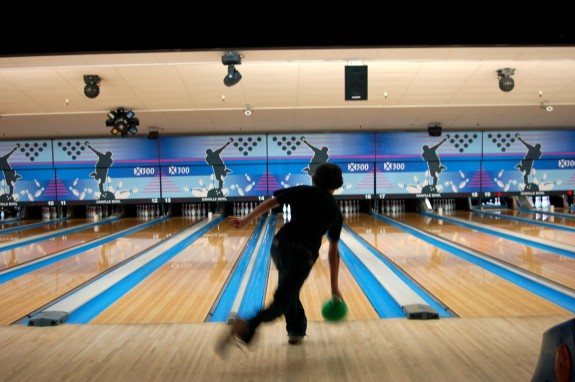
In this post and those that follow, I am going to outline the main reasons people give for being physically inactive and offer some long-term solutions to the challenge of reaching a proper level of physical activity.
Let’s take Lee, a software developer – young, slim and generally in good health. He doesn’t really see any need to go out there and break sweat. Moreover, even the thought of going running is pretty unpleasant for him. Working with Lee as an example, we can get to the root of the Million Dollar Question of exercise psychology: Why do people exercise? One way to find it out is to ask: Why don’t people exercise?
For many individuals, exercise is neither pleasant nor exciting. For instance, running really isn’t much fun when you first start or only do it every now and again. Sometimes the very fact that it is a natural activity means that people don’t have enough information about how to run at the right intensity level, with the correct technique, or about comfortable equipment. The cornerstone of a healthy lifestyle is the choice of an enjoyable form of exercise and workout type.
My first piece of advice for Lee would be to start by choosing moderate-intensity activities he would probably enjoy the most. Exercise is voluntary, remember it’s supposed to increase the quality of life, not increase stress and discomfort! So for Lee the best start on the road to sustainable fitness would be to identify 3 or 4 physical activities that look like fun, and just try them out without pressuring himself over the coming two weeks. Do you know any cool workouts you could suggest to him?
 Users Guide is now in reach of just one click. No matter where you are in Sportlyzer, you can always find the blue “Users Guide” button on the right. Just click it whenever you have questions. If you have more time, check the Users Guide out anyway – you may find some cool features you haven’t tried yet.
Users Guide is now in reach of just one click. No matter where you are in Sportlyzer, you can always find the blue “Users Guide” button on the right. Just click it whenever you have questions. If you have more time, check the Users Guide out anyway – you may find some cool features you haven’t tried yet.






 Individuals with exercise addiction train at a duration, intensity, and frequency beyond that required for healthy exercise and reasonable working load. Most often, people with exercise addiction try to maintain a rigid schedule of intense exercise, and feel guilty when this schedule is violated. Moreover, physical signs similar to drug addictions appear: exercise addicts skip school or work, they forget social and family events, exercise even when ill or tired, and keep detailed training journals of their workouts. For instance, some people reject challenging carreer opportunities in order to get a job as a coach in the gym and be able to exercise whenever possible.
Individuals with exercise addiction train at a duration, intensity, and frequency beyond that required for healthy exercise and reasonable working load. Most often, people with exercise addiction try to maintain a rigid schedule of intense exercise, and feel guilty when this schedule is violated. Moreover, physical signs similar to drug addictions appear: exercise addicts skip school or work, they forget social and family events, exercise even when ill or tired, and keep detailed training journals of their workouts. For instance, some people reject challenging carreer opportunities in order to get a job as a coach in the gym and be able to exercise whenever possible. Aim for your destination, concentrate on the journey. How pleasant it feels to dream about the happy, healthy, and productive person I’ll become after I have got down to it on the January 1st! However, willpower is not enough for long-term success. Willpower is just a good basis for careful goal setting and planning.
Aim for your destination, concentrate on the journey. How pleasant it feels to dream about the happy, healthy, and productive person I’ll become after I have got down to it on the January 1st! However, willpower is not enough for long-term success. Willpower is just a good basis for careful goal setting and planning.

